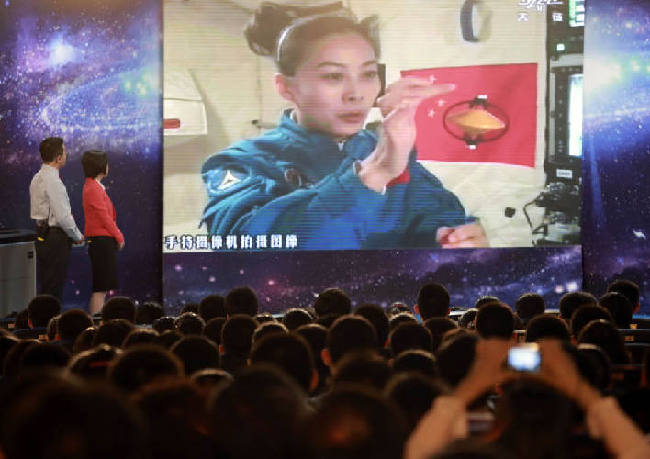China's Fifth Manned Space Exploration
By staff reporter HOU RUILI
 |
| Wang Yaping beams a live physics class to 60 million school children on the earth on June 20. |
ON June 11, Shenzhou-10, China’s fifth manned spacecraft, lifted off from Jiuquan Satellite Launch Center in Gansu Province, for a 15-day mission in low Earth orbit. A safe reentry and touchdown on June 26 marked the success of the mission and saw the crew go into the record books for the longest manned space flight in China’s history.
Over the course of the mission, the Shenzhou-10 craft was docked to China’s Tiangong-1 trial space laboratory module for 12 days, during which the three Chinese astronauts carried out extensive scientific experiments in space technology and medical astronautics. The crew was also the first in China to give a live lecture on the peculiarities of the zero-g environment to a group of excited students back on Earth.
Chinese President Xi Jinping voiced his congratulations on the successful launch of the Shenzhou-10 during a speech at the Launch Center.
China’s fifth manned space mission came only a decade after its first. In 10 years, the country’s manned space program has developed in leaps and bounds. Shenzhou-10 marked the beginning of the space program entering an application-oriented phase. The success of the latest mission has laid foundation for building a comprehensive transportation system to ferry payloads and astronauts between space laboratories, launch sites on earth, and eventually, space stations.
Breakthroughs
During the mission Shenzhou-10 docked with Tiangong-1 twice, once automatically and once with manual input from the crew. On June 25, following separation from Tiangong-1 at 7:05 a.m. Beijing time, Shenzhou-10 returned to Earth after successfully conducting a fly-around and rendezvous test with Tiangong-1.
The successful fly-around and rendezvous was China’s first ever such test, and a valuable experience and key technological triumph that will aid in the building of a space station in the future. Wu Ping, spokeswoman for China’s manned space exploration program, explained that a fly-around requires the spacecraft to change its orbit and adjust its flight path again and again, an extraordinarily complicated task.
The eventual construction of a space station is a key goal in China’s space exploration plans. The space station will consist of three sections – one core unit and two experiment modules, arranged into a T-shaped configuration. According to plans, the core unit will feature two fully integrated frontal docking ports. There will be an additional docking port at the rear of the station, used primarily for cargo supply.
The successful Shenzhou-10 mission also pushed forward the development and improvement of China’s state-of-the-art space technology. The spacecraft’s solar panels marked one significant innovation. “Improvement of the space solar cell arrays is an important step,” said Wang Zhiyi, a scientist with the No.8 China Astronautic Technology Institute. “We put much work into optimizing the polymer glue and curing processes in order to maximize the efficiency-to-weight ratio of the cells.” With the success of the mission and the solar panels, Wang was singled out for commendation by China’s space body.

